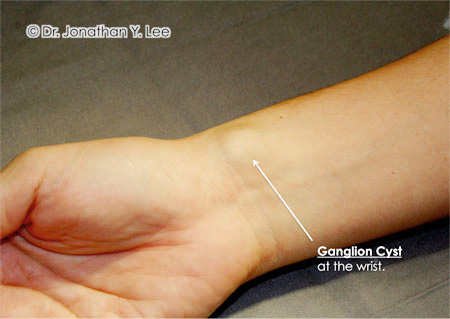WHAT ARE GANGLION CYSTS?
Ganglion cysts are very common lumps within the hand and wrist that occur adjacent to joints or tendons. The most common locations are the top of the wrist (see Figure 1), the palm side of the wrist, the base of the finger on the palm side (Figure 2), and the top of the end joint of the finger (see Figure 3). The ganglion cyst often resembles a water balloon on a stalk (see Figure 1), and is filled with clear fluid or gel. The cause of these cysts is unknown although they may form in the presence of joint or tendon irritation or mechanical changes. They occur in patients of all ages.
These cysts may change in size or even disappear completely, and they may or may not be painful. These cysts are not cancerous and will not spread to other areas.
Figure 1: A common location to have a ganglion cyst is on the back of the wrist.
Figure 2: A ganglion cyst arising from the palmar side (volar aspect) of the wrist.
Figure 3: A mucous cyst is a ganglion cyst that arises from the small joints of the finger.
EVALUATION AND DIAGNOSIS
The diagnosis is usually based on the location of the lump and its appearance. They are usually oval or round and may be soft or very firm. Cysts at the base of the finger on the palm side are typically very firm, pea sized nodules that are tender to applied pressure, such as when gripping. Light will often pass through these lumps, (transillumination with a torchlight) and this can assist in the diagnosis. X-rays may be performed in order to investigate problems in adjacent joints. Cysts at the end joint of the finger (Figure 3) often result from an arthritic bone spur in the underlying joint. Ves may also be injured when the wrist is broken and these injuries will need to be treated in addition to the fracture.
TREATMENT OPTIONS
Treatment can often be non-surgical and simple observation is all that is needed in many cases, especially if they are painless. Up to 50 percent of wrist ganglions may disappear spontaneously.
If the cyst becomes painful, limits activity, or is otherwise unacceptable, several treatment options are available. The use of splints and anti-inflammatory medication can be prescribed in order to decrease pain associated with activities. A needle aspiration can be performed to remove the fluid from the cyst and decompress it.
Surgery to remove the ganglion is recommended when the ganglion is painful or when it interferes with movements. It is also necessary if the ganglion compresses nerves in the wrist, causing numbness or weakness in the hand. This can be done through a short open incision or using an arthroscopic technique (key-hole surgery).
For a brief description of other lumps or tumours that commonly occur in the hand and wrist, read more in our website on on Hand Tumours page.


















